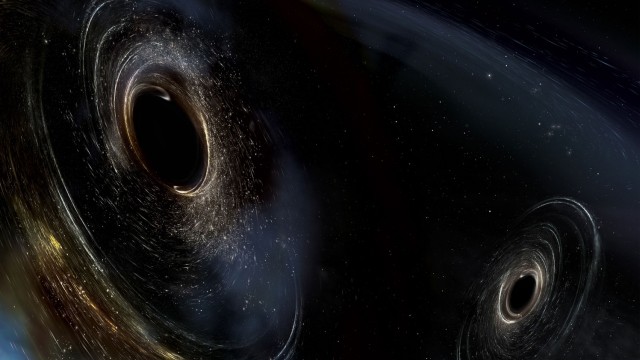New detections and analysis of gravitational waves – announced Saturday, Dec. 1, at the Gravitational Wave Physics and Astronomy Workshop in College Park, Maryland – broaden scientists’ understanding of the entire population of stellar-mass black holes, which are formed from collapsing stars.
The National Science Foundation’s LIGO (Laser Interferometer Gravitational-Wave Observatory) and the European-based Virgo gravitational wave detectors have now detected gravitational waves from a total of 10 stellar-mass binary black hole mergers and one merger of neutron stars, which are the dense, spherical remains of stellar explosions.
Four additional detections provide LIGO Scientific and Virgo Collaboration (LVC) scientists a sufficient amount of data to infer properties that apply to all stellar black holes. Most notably, the Compact Binary Coalescence Rates and Populations subgroup, co-chaired by Northwestern University’s Chris Pankow, deduced that almost all stellar black holes weigh less than 45 times the mass of the sun.
“Gravitational waves give us unprecedented insight into the population and properties of black holes,” said Pankow, who also is a postdoctoral fellow of Northwestern’s Center for Interdisciplinary Exploration and Research in Astrophysics (CIERA). “We now have a sharper picture of both how frequently stellar mass binary black holes merge and what their masses are. These measurements will further enable us to understand how the most massive stars of our Universe are born, live and die.”
Pankow works with the LIGO Scientific Collaboration (LSC) research group led by senior astrophysicist Vicky Kalogera. Kalogera, the Daniel I. Linzer Distinguished University Professor in the Department of Physics and Astronomy in Northwestern’s Weinberg College of Arts and Sciences. Kalogera also is a co-founder and the current director of CIERA, an endowed research center at Northwestern focused on advancing astrophysics studies with an emphasis on interdisciplinary connections.
Two papers describing the new findings are available on the arXiv repository of electronic preprints. “Binary Black Hole Population Properties Inferred from the First and Second Observing Runs of Advanced LIGO and Advanced Virgo” describes the characteristics of the merging black hole population. “GWTC-1: A Gravitational-Wave Transient Catalog of Compact Binary Mergers Observed by LIGO and Virgo during the First and Second Observing Runs” presents a detailed catalog of all the gravitational wave detections.
Chart shows masses of black holes detected so far using gravitational waves.
“The work done by Chris Pankow and the Northwestern group lays the foundation for a much deeper understanding of the nature of black holes and the environments in which they form,” said David Reitze, Executive Director of the LIGO Laboratory, Caltech. “As LIGO and Virgo resume observing in 2019, we will undoubtedly detect many more binary black hole mergers, and thanks to this research, increase our knowledge of the black hole universe.”
The 11 detections occurred during two observing runs from Sept. 12, 2015 to Jan. 19, 2016 and from Nov. 30, 2016 to Aug. 25, 2017. Seven of the detections, including the first detection of binary neutron stars, were previously reported, while four additional detections were announced for the first time at the Dec. 1 research conference, where Pankow presented the new understanding of black hole population characteristics.
Highlights of the new detections include a July 29, 2017 merger that happened roughly 5 billion years ago. An equivalent energy of almost five times the mass of the sun was converted into gravitational radiation. It is the most massive and distant gravitational-wave source ever observed.
A third observing run of the LIGO and Virgo detectors will begin early in 2019 with improved detections. Given the rate of detections calculated from the previous runs, frequent new detections are expected.
100 years passed between Albert Einstein’s prediction of gravitational waves and the first detection. Soon, this could become an everyday event.
The Collaborations
LIGO is funded by NSF and operated by Caltech and MIT, which conceived of LIGO and led the Initial and Advanced LIGO projects. Financial support for the Advanced LIGO project was led by the NSF with Germany (Max Planck Society), the U.K. (Science and Technology Facilities Council) and Australia (Australian Research Council-OzGrav) making significant commitments and contributions to the project. More than 1,200 scientists from around the world participate in the effort through the LIGO Scientific Collaboration, which includes the GEO Collaboration. A list of additional partners is available at https://my.ligo.org/census.php.
The Virgo collaboration consists of more than 300 physicists and engineers belonging to 28 different European research groups: six from Centre National de la Recherche Scientifique (CNRS) in France; 11 from the Istituto Nazionale di Fisica Nucleare (INFN) in Italy; two in the Netherlands with Nikhef; the MTA Wigner RCP in Hungary; the POLGRAW group in Poland; Spain with IFAE and the Universities of Valencia and Barcelona; two in Belgium with the Universities of Liege and Louvain; Jena University in Germany; and the European Gravitational Observatory (EGO), the laboratory hosting the Virgo detector near Pisa in Italy, funded by CNRS, INFN, and Nikhef. A list of the Virgo Collaboration can be found at http://public.virgo-gw.eu/the-virgo-collaboration/. More information is available on the Virgo website at www.virgo-gw.eu.


